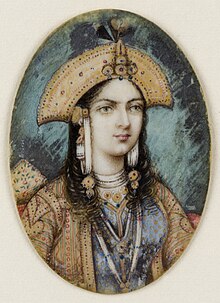 Global Information
Global InformationMumtaz Mahal information
| Mumtaz Mahal | |
|---|---|
| Empress consort of the Mughal Empire Empress mother of the Mughal Empire | |
 Portrait of Mumtaz Mahal on Ivory, 17th‑century, held at the Lahore Museum in Lahore, Pakistan | |
| Padshah Begum | |
| Tenure | 19 January 1628 – 17 June 1631 |
| Predecessor | Nur Jahan |
| Successor | Jahanara Begum |
| Born | Arjumand Banu Begum 29 October 1593 Agra, Mughal Empire |
| Died | 17 June 1631 (aged 37) Burhanpur, Mughal Empire |
| Burial | Taj Mahal, Agra, Uttar Pradesh, India |
| Spouse |
Shah Jahan (m. 1612) |
| Issue among others... |
|
| House | Timurid (by marriage) |
| Father | Abu'l-Hasan Asaf Khan |
| Mother | Diwanji Begum |
| Religion | Shia Islam[1][2][3][4][5] |
Mumtaz Mahal (Arjumand Banu Begum; Persian pronunciation: [mʊmˈt̪aːz mɛˈɦɛl]; lit. 'The Exalted One of the Palace'; 29 October 1593 – 17 June 1631)[6] was the empress consort of Mughal Empire from 1628 to 1631 as the chief consort of the fifth Mughal emperor, Shah Jahan.[7] The Taj Mahal in Agra, often cited as one of the Wonders of the World,[8] was commissioned by her husband to act as her tomb.[9]
Mumtaz Mahal was born Arjumand Banu Begum in Agra to a family of Persian nobility. She was the daughter of Abu'l-Hasan Asaf Khan, a wealthy Persian noble who held high office in the Mughal Empire, and the niece of Empress Nur Jahan, the chief wife of Emperor Jahangir and the power behind the emperor.[10] She was married at the age of 19 on 10 May 1612 or 16 June 1612 to Prince Khurram,[11][12] later known by his regnal name Shah Jahan, who conferred upon her the title "Mumtaz Mahal" (Persian: the exalted one of the palace).[13] Although betrothed to Shah Jahan since 1607,[14] she ultimately became his second wife in 1612.[15][16] Mumtaz and her husband had 14 children, including Jahanara Begum (Shah Jahan's favorite daughter),[17] and the Crown prince Dara Shikoh, the heir-apparent,[18] anointed by his father, who temporarily succeeded him until deposed by Mumtaz Mahal's sixth child, Aurangzeb, who ultimately succeeded his father as the sixth Mughal emperor in 1658.[19]
Mumtaz Mahal died in 1631 in Burhanpur, Deccan (present-day Madhya Pradesh) during the birth of her 14th child, a daughter named Gauhar Ara Begum.[20] Shah Jahan had the Taj Mahal built as a tomb for her, which is considered to be a monument of undying love. As with other Mughal royal ladies, no contemporary likenesses of her are accepted, but imagined portraits were created from the 19th century onwards.
- ^ "The Cause of The Taj:: Mumtaz Mahal". Taj Mahal Official Website. Uttar Pradesh Tourism. Archived from the original on 19 June 2023. Retrieved 3 September 2023.
She was religiously a Shi'a Muslim.
- ^ Khan, Hamza. "Now, Shias assert claim to Taj Mahal". The Indian Express. Lucknow. Archived from the original on 3 September 2023. Retrieved 3 September 2023.
- ^ Srivastava, Piyush (27 November 2014). "Battle for Taj Mahal continues between Shia and Sunni sect leaders". India Today. Lucknow. Archived from the original on 3 September 2023. Retrieved 3 September 2023.
- ^ Shaikh, Ayesha (24 November 2014). "Who is the rightful claimant to Taj Mahal?". The Express Tribune. Archived from the original on 4 September 2023. Retrieved 3 September 2023.
- ^ DHNS (24 November 2014). "After Sunnis, now Shias too claim Taj Mahal". Deccan Herald. Archived from the original on 3 September 2023. Retrieved 3 September 2023.
- ^ Pickthall, Marmaduke William; Asad, Muhammad (1 January 1975). "Islamic Culture". 49. Islamic Culture Board: 196. Archived from the original on 30 August 2023. Retrieved 13 April 2017.
{{cite journal}}: Cite journal requires|journal=(help) - ^ Lach, Donald F.; Kley, Edwin J. Van (1998). Asia in the Making of Europe, Volume III: A Century of Advance. Book 2, South Asia. University of Chicago Press. p. 689. ISBN 9780226466972.
- ^ Tillotson, Giles (2008). Taj Mahal. London: Profile Books. p. 11. ISBN 9781847652478.
- ^ Phillips, Rhonda; Roberts, Sherma, eds. (2013). Tourism, Planning, and Community Development Community Development – Current Issues Series. Routledge. p. 128. ISBN 9781135711887.
- ^ Cite error: The named reference
Thackeraywas invoked but never defined (see the help page). - ^ Khan, Inayat (1990). The Shahjahannama. Translated by Fuller, A. R. Oxford Library Press. p. 6.
- ^ Emperor, Jahangir (1999). Jahangirnama. Translated by Thackston, W. M. Washington D. C; New York: Freer Gallery of Art, Arthur M. Sackler Gallery, Smithsonian Institution; Oxford University Press. p. 137. ISBN 9780195127188.
- ^ Ahmed, Akbar S. (2009). Islam Today a Short Introduction to the Muslim World. London: I.B. Tauris & Co. p. 94. ISBN 9780857713803.
- ^ Tillotson 2012, p. 20.
- ^ Tillotson 2012, p. 3.
- ^ Tillotson 2012, p. 27.
- ^ Richards, J.F. (1995). Mughal empire (Transferred to digital print. ed.). Cambridge, Eng.: Cambridge University Press. p. 126. ISBN 9780521566032.
- ^ Balabanlilar, Lisa (2015). Imperial Identity in the Mughal Empire: Memory and Dynastic Politics in Early Modern South and Central Asia. I.B.Tauris. p. 131. ISBN 9780857732460.
- ^ Esposito, John L. (2004). The Oxford Dictionary of Islam. Oxford University Press. p. 29. ISBN 9780199757268. Archived from the original on 30 August 2023. Retrieved 1 December 2020.
- ^ Kumar, Anant (January–June 2014). "Monument of Love or Symbol of Maternal Death: The Story Behind the Taj Mahal". Case Reports in Women's Health. 1. Elsevier: 4–7. doi:10.1016/j.crwh.2014.07.001. Retrieved 21 December 2015.